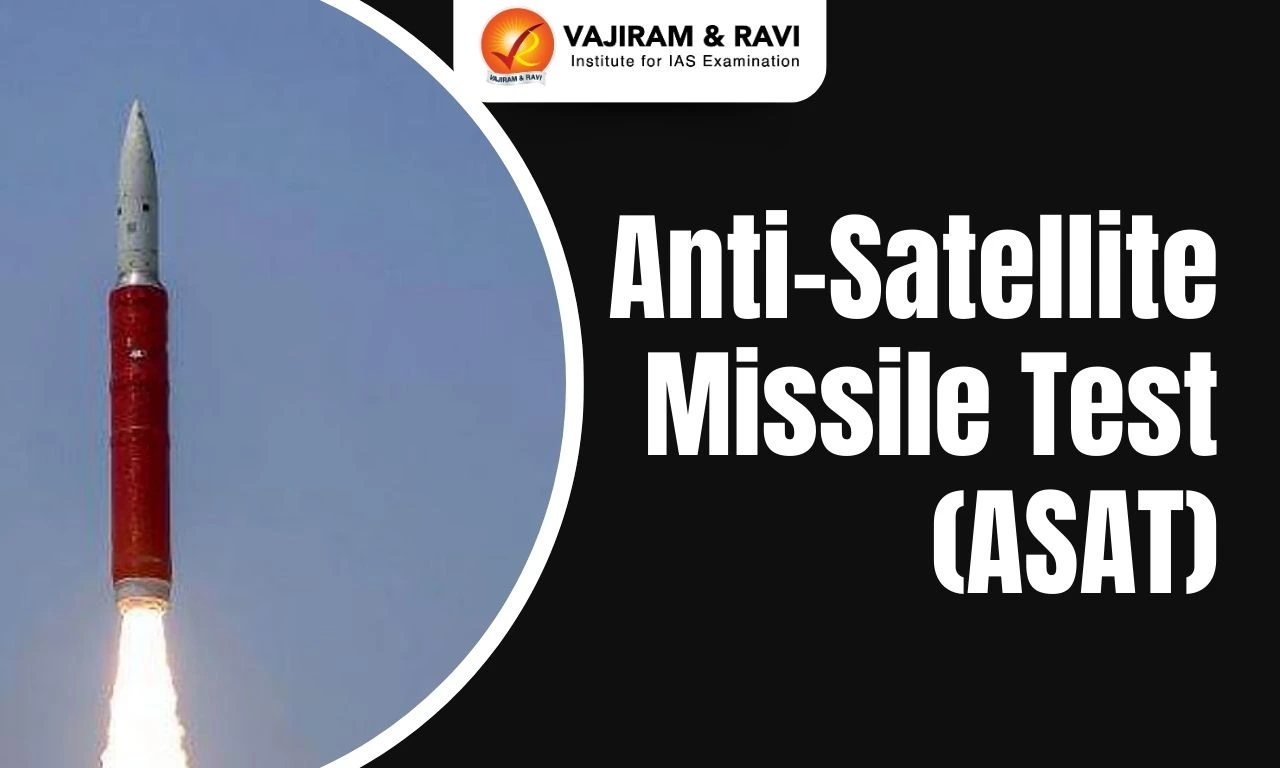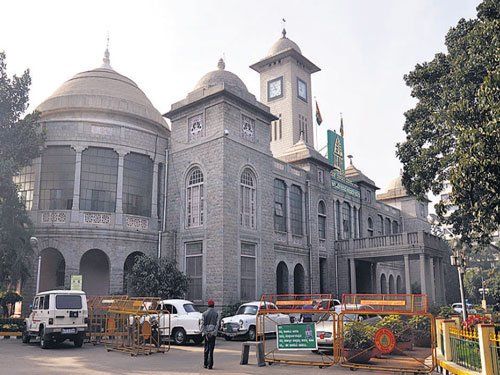Anti-satellites (ASATs) are weapons designed to destroy or disable satellites in orbit. They can be ground-based, air-based, or space-based. ASATs can use various methods to attack satellites, including kinetic impact, lasers, and directed energy weapons.
In March 2019, India successfully conducted Mission Shakti, an anti-satellite missile test, making India the fourth country in the world to have demonstrated the ability to destroy a satellite in orbit.
Anti-Satellite Weapons (ASAT)
Anti-satellite (ASAT) technology refers to the capability to intercept, disable, or destroy satellites in orbit. This technology is primarily developed for defence and strategic purposes.
Types of Anti-Satellite Weapons
ASATs are broadly classified into two types: those that employ brute force and those that do not.
- Kinetic energy methods: This involves launching a missile that intercepts and physically collides with the target satellite to destroy it.
- The kinetic energy ASATs physically collide with satellites and can reach altitudes. These ASATs can be ballistic missiles, drones, and other satellites.
- Non-kinetic methods: They use non-physical attacks such as cyber-attacks, jamming, and even lasers to blind satellites without physically destroying them.
- All of these attacks can be launched from the air, low orbit, or even ground installations.
Other Countries with ASAT Technology
ASATs were first developed during the Cold War era. They have never been used in warfare, but have been used to remove decommissioned satellites. Besides India, three other countries have successfully demonstrated anti-satellite (ASAT) technology in tests; the United States, Russia, China, and India.
| Country | ASAT Missile/Weapon | |
| USA | Bold Orion air-launched ballistic missile (ALBM) | |
| Russia (Former Soviet Union) | Nudol Missile | |
| China | SC-19 ASAT missile | |
Need for ASAT Technology
The development of Anti-Satellite (ASAT) weapons is a complex and controversial topic with both strategic and security considerations. While ASAT weapons have their uses, it's essential to understand the need for them in the broader context of national security and strategic goals.
- National security: ASAT weapons can be developed with the goal of protecting national security interests such as safeguarding critical infrastructure, military communications, and intelligence-gathering capabilities that rely on satellites.
- Destroying retired satellites: There are many satellites in space right now, many of which have outlived their usefulness and are orbiting aimlessly.
- ASATs can be used to destroy these satellites.
- Deterrence: The possession of ASAT capabilities can act as a deterrent to potential adversaries. Knowing that a nation can defend its space assets and retaliate if its satellites are targeted may discourage hostile actions in space.
- For instance, China was not impressed by India's ASAT demonstration which neutralises China's counter-space capabilities.
- Technological advancements: Advances in missile and space technology make it feasible for more nations to develop ASAT capabilities.
- It is often seen as a natural progression in a country's technological evolution, particularly when it already has experience in space research and missile technology.
Mission Shakti
On March 27, 2019, the Defence Research and Development Organisation (DRDO) from Dr. APJ Abdul Kalam Island in Odisha, successfully neutralised a satellite in space with its anti-satellite (ASAT) missile test ‘Mission Shakti’, a part of the Indian Ballistic Missile Defence Programme.
- Test objective: Mission Shakti aimed to demonstrate India's ASAT capabilities by destroying a defunct Indian satellite in a low Earth orbit (LEO) at an altitude of approximately 283 kilometres.
- The entire effort was indigenous, which demonstrated the Nation’s capability to develop such complex and critical missions.
- The weapon used: The Prithvi Delivery Vehicle Mark-II (PDV MK-II), developed by India's DRDO, collided with and destroyed an Indian Microsat-R satellite in flight.
- It was the country's first ASAT missile test.
Significance of Mission Shakti
- Strengthened strategic position: The success of Mission Shakti positioned India as a spacefaring nation with advanced ASAT capabilities, bolstering its national security.
- It made India the fourth country with ASAT capabilities after the USA, Russia, and China.
- The mission's success demonstrated DRDO's technical prowess and ability to protect the country's assets in space, the fourth dimension of warfare.
- Signalling deterrence: India's ASAT program was a signal of deterrence that it possesses the capability to protect its space assets.
- This signals India's preparedness to respond to any potential enemy attack on its satellites in the future, serving as a deterrence strategy.
- Validation of Ballistic Missile Defense Technologies: The ASAT test also validated various emerging Indian ballistic missile defence technologies, contributing to India's broader defence capabilities.
Implications of Anti-Satellite Weapons
The development and testing of ASAT technology have significant implications for space security and international relations.
- Space debris: Destructive ASAT tests result in the creation of a substantial amount of space debris, posing a severe threat to other satellites and spacecraft in space, increasing the risk of collisions.
- Kessler Syndrome: It can lead to Kessler Syndrome, a situation where an increasing amount of space debris in orbit leads to a self-sustaining cascade of collisions, creating more debris and making space activities increasingly hazardous.
- Race for arms control: The proliferation of ASAT capabilities may lead to an arms race in space, resulting in the weaponisation of space.
- International concern: The consequences of ASAT testing, especially in light of the dangers of debris, have prompted calls for a global ban on destructive ASAT tests.
Last updated on December, 2025
→ Check out the latest UPSC Syllabus 2026 here.
→ Join Vajiram & Ravi’s Interview Guidance Programme for expert help to crack your final UPSC stage.
→ UPSC Mains Result 2025 is now out.
→ UPSC Notification 2026 is scheduled to be released on January 14, 2026.
→ UPSC Calendar 2026 is released on 15th May, 2025.
→ The UPSC Vacancy 2025 were released 1129, out of which 979 were for UPSC CSE and remaining 150 are for UPSC IFoS.
→ UPSC Prelims 2026 will be conducted on 24th May, 2026 & UPSC Mains 2026 will be conducted on 21st August 2026.
→ The UPSC Selection Process is of 3 stages-Prelims, Mains and Interview.
→ UPSC Result 2024 is released with latest UPSC Marksheet 2024. Check Now!
→ UPSC Prelims Result 2025 is out now for the CSE held on 25 May 2025.
→ UPSC Toppers List 2024 is released now. Shakti Dubey is UPSC AIR 1 2024 Topper.
→ UPSC Prelims Question Paper 2025 and Unofficial Prelims Answer Key 2025 are available now.
→ UPSC Mains Question Paper 2025 is out for Essay, GS 1, 2, 3 & GS 4.
→ UPSC Mains Indian Language Question Paper 2025 is now out.
→ UPSC Mains Optional Question Paper 2025 is now out.
→ Also check Best IAS Coaching in Delhi


















